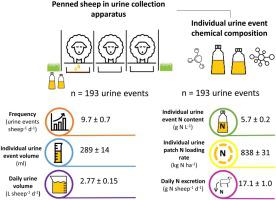当前位置:
X-MOL 学术
›
Agric. Ecosyst. Environ.
›
论文详情
Our official English website, www.x-mol.net, welcomes your feedback! (Note: you will need to create a separate account there.)
Sheep urination frequency, volume, N excretion and chemical composition: Implications for subsequent agricultural N losses
Agriculture, Ecosystems & Environment ( IF 6.6 ) Pub Date : 2020-10-01 , DOI: 10.1016/j.agee.2020.107073 Karina A. Marsden , Lucy Lush , Jon. A. Holmberg , Mick J. Whelan , Andrew J. King , Rory P. Wilson , Alice F. Charteris , Laura M. Cardenas , Davey L. Jones , David R. Chadwick
Agriculture, Ecosystems & Environment ( IF 6.6 ) Pub Date : 2020-10-01 , DOI: 10.1016/j.agee.2020.107073 Karina A. Marsden , Lucy Lush , Jon. A. Holmberg , Mick J. Whelan , Andrew J. King , Rory P. Wilson , Alice F. Charteris , Laura M. Cardenas , Davey L. Jones , David R. Chadwick

|
Abstract Ruminant urine patches are potential sites of reactive nitrogen (N) loss to the environment. Quantification of N losses from grazed grasslands requires measurement of the frequency of urine deposition, as well as its volume and chemical composition. However, studies to date are typically restricted to analyses of few replicate animals and urination events, especially for sheep. Here, we present data on urine frequency, volume, chemical composition (n = 193 events from n = 6 sheep) and metabolomic profile (n = 4–5 events from n = 4–5 sheep) from penned sheep. Differences in urine parameters and chemical composition data were compared seasonally and between two sites (improved and semi-improved pasture). Sheep urinated 8–11 times d−1, assuming time within pens represented a 24 h period. The mean urine event volume recorded was 289 ± 14 mL, from which we estimated a daily urine production value of 2.77 ± 0.15 L urine sheep−1 d−1. Daily urine N excretion and individual urine N concentrations were greater from sheep in improved pasture (26.7 ± 2.3 g N sheep−1 d−1; 7.0 ± 0.2 g N L−1) compared to those in semi-improved pasture (16.7 ± 1.2 g N sheep−1 d−1; 5.5 ± 0.4 g N L−1), but this did not equate to greater individual urine patch N loadings due to site differences in the urine-to-soil surface area influenced (17.5 L m-2 at the semi-improved site and 8.9 L m-2 at the improved site). Urine chemical composition varied seasonally and by site. Site- and season-specific urine should, therefore, be used in studies assessing N losses from urine patches. Based on the urine chemical composition data, we provide an updated artificial sheep urine ‘recipe’ which could be utilised to replicate natural sheep urine. The urine metabolomic profile clustered according to pasture quality, while clustering according to season was less evident. Our results provide important information for experimental and modelling studies assessing the scale and nature of N pollution arising from sheep-grazed pastures.
中文翻译:

绵羊排尿频率、量、氮排泄和化学成分:对随后农业氮损失的影响
摘要 反刍动物尿斑是活性氮 (N) 向环境流失的潜在场所。量化放牧草地的氮损失需要测量尿液沉积的频率,以及它的体积和化学成分。然而,迄今为止的研究通常仅限于对少数重复动物和排尿事件的分析,尤其是对绵羊。在这里,我们提供了来自圈养绵羊的尿液频率、体积、化学成分(来自 n = 6 只羊的 n = 193 个事件)和代谢组学特征(来自 n = 4-5 只绵羊的 n = 4-5 个事件)的数据。季节性地和两个地点(改良和半改良牧场)之间的尿液参数和化学成分数据的差异进行了比较。假设围栏内的时间代表 24 小时,绵羊排尿 8-11 次 d-1。记录的平均尿液事件体积为 289 ± 14 mL,从中我们估计每天的尿液产生值为 2.77 ± 0.15 L 尿羊-1 d-1。与半改良牧场(16.7 ± 1.2 g)相比,改良牧场(26.7 ± 2.3 g N 绵羊−1 d−1;7.0 ± 0.2 g NL−1)的每日尿氮排泄量和个体尿氮浓度更高N 绵羊−1 d−1;5.5 ± 0.4 g NL−1),但这并不等同于更大的个体尿斑 N 负荷,这是由于受影响的尿液到土壤表面积的位点差异(17.5 L m-2 at半改进场地和改进场地的 8.9 L m-2)。尿液化学成分因季节和地点而异。因此,特定地点和季节的尿液应用于评估尿斑中氮损失的研究。根据尿液化学成分数据,我们提供了一种更新的人造羊尿“配方”,可用于复制天然羊尿。尿液代谢组学特征根据牧草质量聚类,而根据季节的聚类不太明显。我们的结果为评估羊放牧牧场产生的氮污染的规模和性质的实验和建模研究提供了重要信息。
更新日期:2020-10-01
中文翻译:

绵羊排尿频率、量、氮排泄和化学成分:对随后农业氮损失的影响
摘要 反刍动物尿斑是活性氮 (N) 向环境流失的潜在场所。量化放牧草地的氮损失需要测量尿液沉积的频率,以及它的体积和化学成分。然而,迄今为止的研究通常仅限于对少数重复动物和排尿事件的分析,尤其是对绵羊。在这里,我们提供了来自圈养绵羊的尿液频率、体积、化学成分(来自 n = 6 只羊的 n = 193 个事件)和代谢组学特征(来自 n = 4-5 只绵羊的 n = 4-5 个事件)的数据。季节性地和两个地点(改良和半改良牧场)之间的尿液参数和化学成分数据的差异进行了比较。假设围栏内的时间代表 24 小时,绵羊排尿 8-11 次 d-1。记录的平均尿液事件体积为 289 ± 14 mL,从中我们估计每天的尿液产生值为 2.77 ± 0.15 L 尿羊-1 d-1。与半改良牧场(16.7 ± 1.2 g)相比,改良牧场(26.7 ± 2.3 g N 绵羊−1 d−1;7.0 ± 0.2 g NL−1)的每日尿氮排泄量和个体尿氮浓度更高N 绵羊−1 d−1;5.5 ± 0.4 g NL−1),但这并不等同于更大的个体尿斑 N 负荷,这是由于受影响的尿液到土壤表面积的位点差异(17.5 L m-2 at半改进场地和改进场地的 8.9 L m-2)。尿液化学成分因季节和地点而异。因此,特定地点和季节的尿液应用于评估尿斑中氮损失的研究。根据尿液化学成分数据,我们提供了一种更新的人造羊尿“配方”,可用于复制天然羊尿。尿液代谢组学特征根据牧草质量聚类,而根据季节的聚类不太明显。我们的结果为评估羊放牧牧场产生的氮污染的规模和性质的实验和建模研究提供了重要信息。

























 京公网安备 11010802027423号
京公网安备 11010802027423号